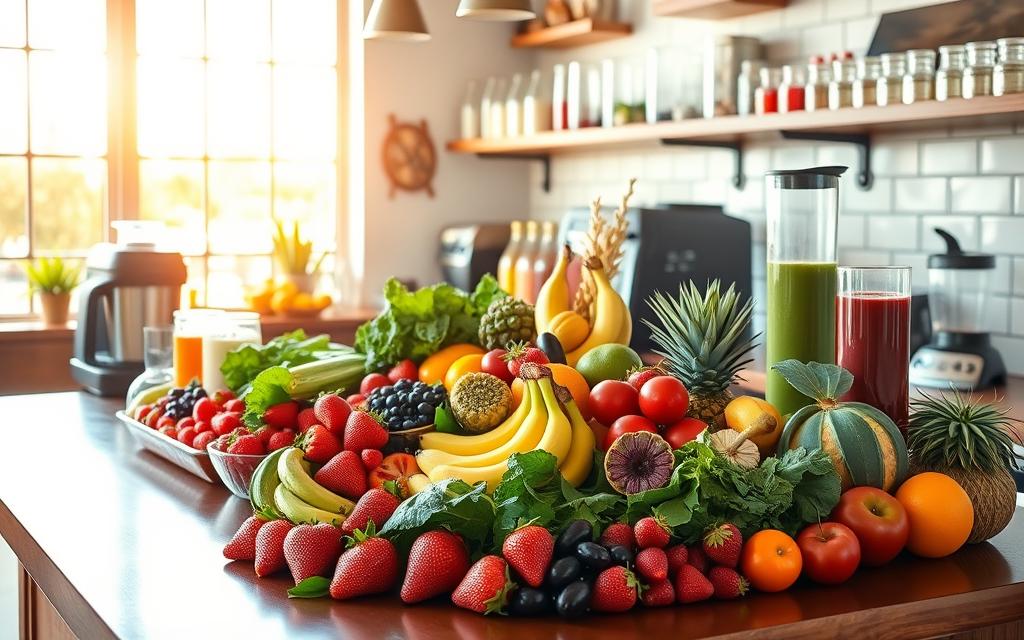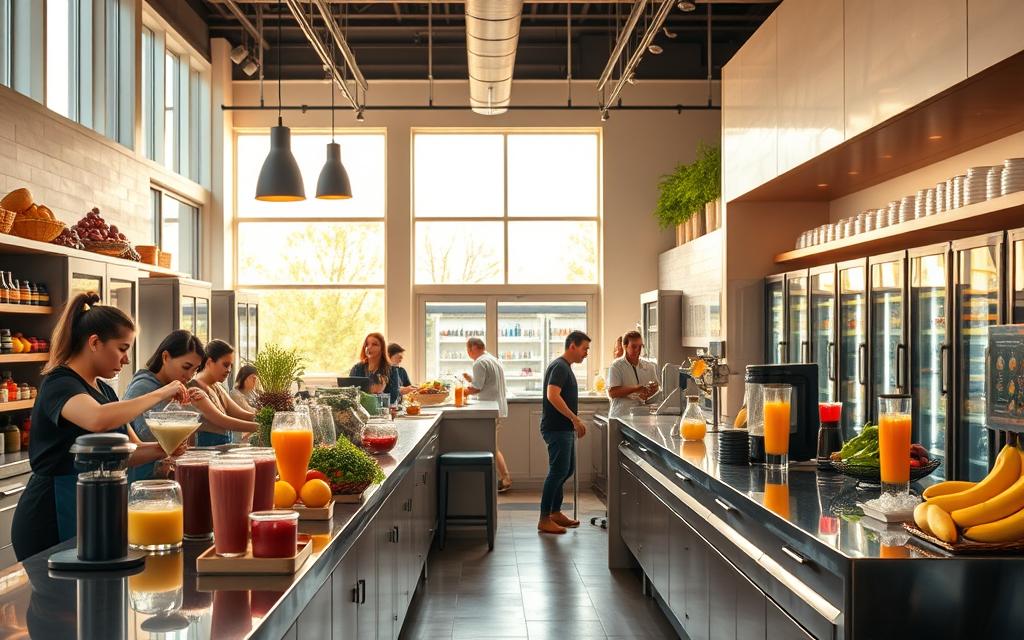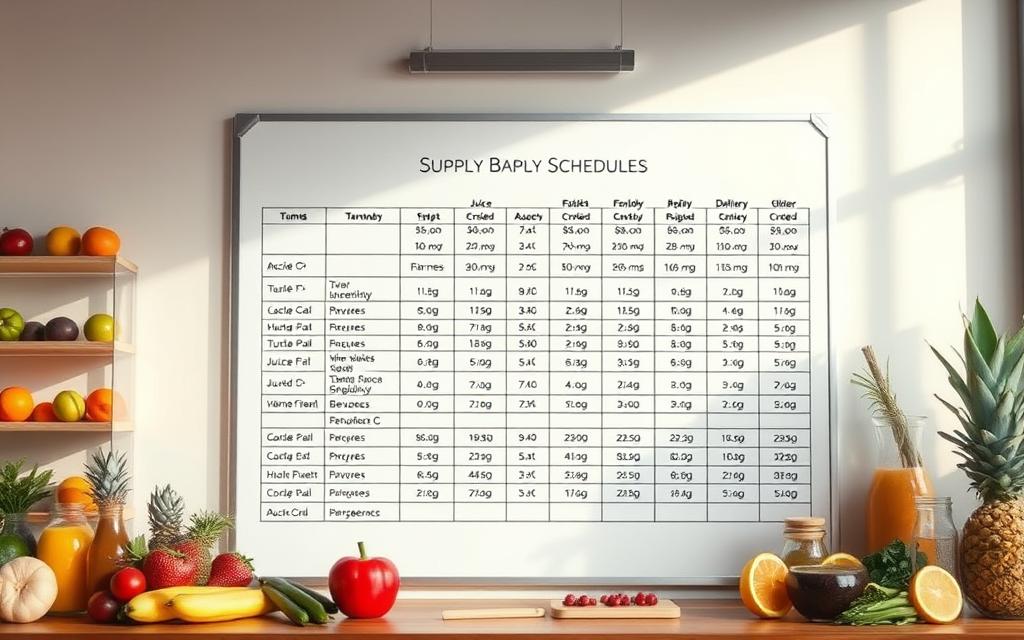Running a successful juice bar requires careful planning, especially when it comes to managing your inventory and production. A supply schedule is like a roadmap that helps you track how many smoothies you can make at different price points. This dynamic chart adjusts based on your inventory, demand, and how much you can produce. It’s all about finding that sweet spot where your prices meet customer demand without overstocking or running out of key ingredients.
Imagine your juice bar during peak hours. Without a solid plan, you might struggle to keep up with orders. A supply schedule ensures you’re prepared for any situation. It’s not just about having enough fruits and juices; it’s about forecasting demand and making sure your production can handle it. By linking your supply schedule to your business strategy, you can maintain consistency and keep your customers happy.
Whether you’re just starting out or looking to optimize your current operations, understanding how to create a supply schedule is essential. It’s the backbone of your business plan, helping you stay organized and profitable. Let’s dive into how you can set up a supply schedule that works for your juice bar.
Key Takeaways
- A supply schedule helps you manage inventory and production efficiently.
- It acts as a dynamic chart, adjusting to changes in demand and supply.
- Forecasting is crucial to ensure you’re prepared for peak times.
- Linking your supply schedule to your business strategy improves consistency.
- A well-planned schedule is essential for maintaining profitability and customer satisfaction.
Understanding the Supply Schedule Essential Concepts
Managing a smoothie shop’s supply schedule is crucial for balancing inventory and meeting customer demand. This schedule serves as a roadmap, showing how many products can be made at various price points. It’s a dynamic tool that adjusts based on inventory levels, demand, and production capacity.
Defining the Supply Schedule for a Smoothie Shop
A supply schedule in this context is a chart that shows the quantity of smoothies a shop can produce at different prices. It helps in planning inventory and sales strategies, ensuring the shop remains profitable without overstocking or running short of key ingredients.
Mapping Price to Production and Demand
The supply curve shows how price changes affect production levels. As prices rise, production typically increases to meet higher demand. For example:
| Price Range | Production Level | Demand Level |
|---|---|---|
| $5 – $7 | High | Very High |
| $7 – $9 | Medium | High |
| Above $9 | Low | Medium |
Understanding this relationship helps smoothie shops adjust their offerings based on customer preferences and market trends, ensuring they stay competitive and profitable.
Key Determinants Influencing Smoothie Supply
When it comes to managing a smoothie shop, several factors play a crucial role in determining supply levels. These elements ensure that your shop remains stocked appropriately without overstocking or running low on essential ingredients. Understanding these determinants is vital for maintaining a smooth operation and meeting customer demand effectively.
Price, Production Costs, and Market Conditions
The price of smoothies and the associated production costs significantly influence supply. As prices rise, production typically increases to meet higher demand. However, market conditions can fluctuate, affecting how much you can produce. For instance:
- At lower price points, production might focus on high-demand items to maximize sales.
- As prices increase, smoothie shops may adjust their menus to offer premium options, balancing quality and cost.
Market trends, such as the popularity of certain fruits or dietary preferences, also shape production strategies. Owners must stay attuned to these changes to maintain profitability and customer satisfaction.
External Factors: Weather, Taxes, and Subsidies
External factors like weather conditions and government policies can also impact smoothie supply. Favorable weather in regions like California and Florida can boost the availability of fresh fruits, while adverse weather elsewhere might strain supply chains. Additionally, local taxes and subsidies influence production costs and, consequently, the pricing of smoothies.

By understanding and adapting to these external influences, smoothie shop owners can better navigate challenges and capitalize on opportunities, ensuring their businesses remain competitive and resilient in the ever-changing market landscape.
what is needed to create a supply schedule for a fruit smoothie shop?
Creating an effective supply schedule for a smoothie shop involves understanding production costs and market demand. Changes in production costs and shifts in demand require continuous adjustments to ensure the schedule remains accurate and relevant.
For a company to thrive, the supply schedule must pinpoint exact production levels at varying price points. Market monitoring plays a crucial role in keeping the schedule aligned with current trends and customer preferences.
Even minor shifts in cost or demand can significantly impact the business strategy. Staying attuned to these changes ensures the company remains competitive and profitable.
- Production costs directly influence supply levels.
- Demand fluctuations must be anticipated to avoid overstocking or shortages.
- Market trends guide production strategies, ensuring offerings meet customer expectations.
By focusing on these elements, a smoothie shop can maintain a balanced inventory and meet customer demand effectively, ensuring long-term success.
Inventory Management & Production Planning Strategies
Effective inventory management and production planning are the backbone of a successful smoothie shop. These strategies ensure that your business runs smoothly, meeting customer demand while maintaining profitability. A well-structured approach helps in balancing stock levels and production, avoiding overstocking or shortages.
Forecasting Demand and Setting Financial Forecasts
Forecasting demand is crucial for aligning production with expected sales. By analyzing historical data and current market trends, you can predict customer preferences and plan your inventory accordingly. Setting financial forecasts ensures that your production aligns with anticipated profits, helping you stay within budget and maximize margins.
Adjusting Production in Response to Market Trends
Market trends play a significant role in shaping production levels. Stay attuned to changes in consumer preferences, such as increased demand for health-conscious options or seasonal favorites. By adjusting your production schedule based on these trends, you can ensure that your offerings meet customer expectations and drive sales. Real-time data and innovative planning tools can help your team make informed decisions quickly.
A collaborative team and efficient management are key to implementing these strategies effectively. By integrating advanced planning tools and maintaining open communication, your team can respond swiftly to market changes, ensuring your smoothie shop remains competitive and profitable.
Essential Equipment for Fruit Smoothie Production
Equipping your smoothie bar with the right tools is vital for producing high-quality smoothies efficiently. The proper machinery not only ensures consistency but also enhances productivity, making it easier to meet customer demand.
Commercial Kitchen Essentials: Fridges, Freezers, and Blenders
At the heart of every successful smoothie bar are reliable commercial-grade fridges and freezers. These units maintain the freshness of your ingredients, ensuring that every smoothie tastes its best. High-powered blenders are another essential, capable of handling tough ingredients like frozen fruits and ice with ease, which is crucial during busy hours.
Maintaining Efficiency with Juicers and Food Processors
Juicers and food processors play a significant role in streamlining your production process. Cold press juicers, for instance, extract up to 99% pure juice, preserving nutrients and flavor. Food processors quickly chop and mix ingredients, allowing for consistent results in every batch. Together, these tools help maintain a steady supply of fresh, high-quality smoothies.
- Commercial-grade fridges and freezers keep ingredients fresh for longer.
- High-powered blenders handle tough ingredients efficiently.
- Cold press juicers offer superior nutrient retention.
- Food processors ensure consistent ingredient preparation.
Investing in the right equipment is a strategic concept that ties directly into managing your inventory effectively. By researching and choosing innovative appliances, you can transform your operational efficiency, ensuring your smoothie bar runs smoothly and meets customer expectations.
Operational Best Practices for Juice Bar and Restaurant Settings
Running a juice bar business efficiently requires adopting proven operational best practices. These strategies help streamline daily operations, ensuring your business runs smoothly and remains profitable. A well-structured approach is essential for maintaining customer satisfaction and staying ahead of the competition.
Streamlining Supply Chains and Inventory Systems
Effective supply chain management is critical for any juice bar business. A reliable supply chain ensures that fresh ingredients are always available, reducing the risk of stockouts. Implementing an optimized inventory system allows you to track stock levels in real-time, making it easier to reorder supplies as needed. For example, during peak quarters, having a robust inventory system can help manage increased demand without overstocking.
Integrating Technology with POS Comparison Tools
Modern technology plays a vital role in enhancing operational efficiency. Integrating advanced POS systems with comparison tools provides valuable insights into sales trends and customer preferences. These tools help you monitor resource usage, optimize pricing, and identify areas for improvement. By leveraging technology, you can make data-driven decisions to boost your juice bar business’s performance and profitability.
| Practice | Benefit | Implementation |
|---|---|---|
| Quarterly Inventory Audits | Ensures accurate stock levels | Conduct audits every quarter to align with financial forecasts |
| POS System Integration | Enhances sales tracking | Use comparison tools to analyze sales data and adjust strategies |
| Supply Chain Optimization | Reduces operational costs | Partner with reliable suppliers and implement just-in-time ordering |
By adopting these best practices, your juice bar business can maintain a competitive edge in the market. Regularly reviewing and updating your operational strategies ensures long-term success and customer satisfaction.

Adapting to Market Dynamics and Cost Variations
Adapting to market dynamics and cost variations is essential for maintaining a competitive edge in the bar business. Economic factors like tax changes and policy shifts can significantly impact production costs and supply capacity. These external pressures require a dynamic business plan that can adjust to new conditions.
Evaluating the Impact of Economic and Political Factors
Economic indicators and political decisions, such as tax adjustments, influence production costs and supply levels. For instance, a tax hike can increase operational expenses, affecting the overall business plan. Similarly, subsidies might reduce costs, allowing for more flexibility in production strategies.
Market dynamics also play a role in shaping supply schedules. External factors like weather conditions or global events can disrupt ingredient availability and transportation, impacting the bar business’s ability to meet demand. Implementing a dynamic supply schedule helps navigate these challenges effectively.
| Factor | Impact on Business | Strategy |
|---|---|---|
| Tax Changes | Increases/Decreases Production Costs | Adjust Pricing and Supply Levels |
| Policy Shifts | Influences Operational Costs | Adapt Business Plan |
| Market Trends | Shapes Consumer Demand | Optimize Inventory |
By utilizing advanced restaurant pos comparison tools, businesses can analyze sales data and market trends, enabling informed decisions. A pos comparison tool helps in identifying areas for cost reduction and efficiency improvement, ensuring the business remains profitable despite external pressures.
Remaining adaptable is crucial for long-term success. Regularly reviewing and adjusting the business plan ensures the bar business stays resilient and competitive in a constantly changing market landscape.
Conclusion
Efficient supply schedule management is the cornerstone of a thriving smoothie shop. By carefully balancing inventory, production, and pricing, businesses can ensure they meet customer demand without overstocking. This approach not only optimizes resources but also enhances profitability.
Key factors like pricing, production costs, and market trends significantly influence supply levels. Investing in quality equipment, such as high-performance blenders and efficient juicers, streamlines production and maintains consistency. Additionally, staying attuned to external factors like weather conditions and economic changes helps in adapting supply strategies effectively.
Integrating modern technology, such as advanced restaurant POS systems and comparison tools, provides valuable insights into sales trends and operational efficiency. Leveraging social media can also enhance customer engagement and streamline operations, driving business growth.
Regularly updating the supply schedule based on internal data and market research ensures it remains relevant and effective. Encouraging owners to adopt best practices and strategic planning fosters long-term success in the competitive smoothie shop environment.
Source Links
- https://www.webstaurantstore.com/guide/1045/juice-bar-equipment-list.html?srsltid=AfmBOoqRPLK0oayBuDwXFspav6IOznETx54a5Jauib2u_RivBRh5gpi2
- https://mysobol.com/how-to-start-a-smoothie-business-equipment-costs-and-benefits/
- https://dojobusiness.com/blogs/news/fruit-juice-bar-complete-guide
- https://www.webstaurantstore.com/article/632/start-a-juice-or-smoothie-business.html?srsltid=AfmBOoqgpM8Xp9vtby_peAMdObrZQdARElh657F6UOY9DksfBea1FEFZ
- https://www.joinhomebase.com/blog/how-to-start-a-smoothie-business
- https://www.ibisworld.com/united-states/industry/juice-smoothie-bars/4325/
- https://www.datalibraryresearch.com/market-analysis/smoothies-market-5189
- https://www.hopkinsmedicine.org/health/wellness-and-prevention/how-to-make-a-healthy-smoothie
- https://www.maricopa.gov/DocumentCenter/View/5797/Minimum-Requirements-PDF
- https://www.michigan.gov/mdard/licensing/food/foodest/food-establishment-licensing-details-faq-and-step-by-step-guide
- https://katanamrp.com/blog/food-industry-inventory-management/
- https://www.ontimeedge.com/blog/five-questions-every-manufacturing-executive-asks-about-capacity-planning
- https://www.relexsolutions.com/resources/managing-retail-grocery-supply-chains/
- https://www.webstaurantstore.com/guide/1045/juice-bar-equipment-list.html?srsltid=AfmBOoobbuhQsyARmvPgZXr6NDxVcGkAvVEN424pRmVt2dgkpx-2uuV4
- https://www.ckitchen.com/blog/2021/7/juice-bar-equipment-list.html?srsltid=AfmBOorFbiFERmlEEha03f6WCMUVaaZZKeHL-vWpNDxpLeIzauTRS_Jv
- https://www.webstaurantstore.com/article/632/start-a-juice-or-smoothie-business.html?srsltid=AfmBOoqva0Cs-TCbiNhdAFziduEevsJ7n3k5ee5jqE_i2pqCuQn3itM5
- https://www.webstaurantstore.com/guide/1045/juice-bar-equipment-list.html?srsltid=AfmBOoo5pmz0gOjMRoSepDAuXJznXBZHNdxrcaMP_BNoGIu4T9rL3YOB
- https://www.lightspeedhq.com/blog/how-to-start-a-juice-bar/
- https://blog.osum.com/smoothie-market-analysis/
- https://www.pricefx.com/learning-center/food-beverage-pricing-strategy-tips-types-examples
- https://www.mordorintelligence.com/industry-reports/smoothies-market
- https://www.profitableventure.com/supply-schedule-fruit-smoothie-shop/
- https://www.tropicalacai.com/smoothie-shop-essentials-101-building-a-base-with-acai-and-pitaya/

